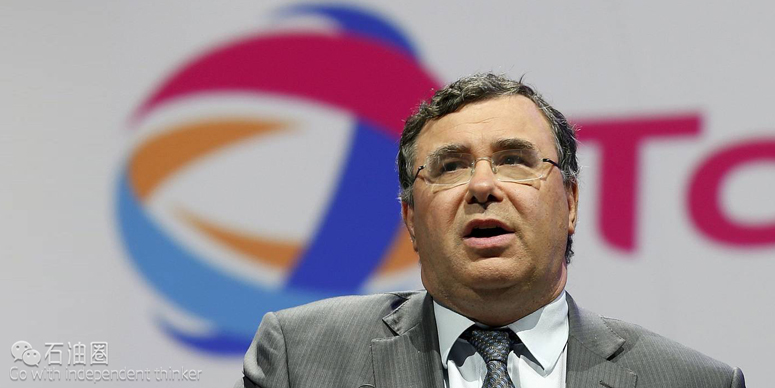Is it time for oil and gas companies to jump on the renewables bandwagon?
Total SA chairman and chief executive officer Patrick Pouyanne says his company want to make low-carbon businesses a genuine and profitable growth driver. Image: World Economic Forum
Since the days around the turn of the century when oil supermajor BP tried to rebrand itself as Beyond Petroleum—amid a major R&D effort to diversify into renewables which lost steam a decade later when the company largely divested of its renewables portfolio—it appears the trend has returned.
Oil and gas companies, particularly in Europe, are once again making headway in diversifying into renewable and low-carbon energy production. Some of them, in fact, have quickly become leading producers of low carbon energy.
Total SA is leading the charge with a major drive into solar power and energy storage. The US$1.4 billion purchase of solar-panel maker SunPower Corp. in 2011 helped turn the oil company into a major solar player, while the acquisition this year of battery maker Saft Group SA put it in the big leagues of solar-plus-storage and distributed generation technology.
Europe
In a report released in May, Integrating Climate into our Strategy , Total chairman and chief executive officer Patrick Pouyanne stated: “COP21 was definitely a watershed,” and said the company’s new ambition could be summed up by the motto “20 per cent in 20 years. We want to make low-carbon businesses a genuine and profitable growth driver accounting for around 20 per cent of our portfolio in 20 years’ time.”
How serious is he? Last month, Pouyanne named Philippe Sauquet, the former boss of Total’s refining and chemicals, to lead its newly created gas, renewables and power unit in what Bloomberg described as a sign that the oil major sees potential growth in the division. Pouyanne “wants to put somebody who he trusts in this new gas, renewables and power area because that’s going to be increasingly important going forward,” Iain Reid, head of oil and gas research at Macquarie Group Ltd., told Bloomberg.
The moves haven’t gone unnoticed. “Amid falling profits and long-term questions, global oil ‘supermajors’ need to follow in the footsteps of Total—which recently bought energy storage company Saft for $1 billion—and explore opportunities not only in battery but also solar and distributed generation,” Lux Research said on Tuesday.
Despite shrinking profits since the price of oil collapsed two years ago, Lux Research noted the supermajors—BP, Chevron, ConocoPhillips, Exxon Mobil, Royal Dutch Shell and Total—are sitting on cash piles ranging from $5 billion to $30 billion each.
“Worthwhile battery companies continue to gain value and build momentum with each passing day, as do other opportunities toward a distributed generation future,” said Cosmin Laslau, Lux Research senior analyst. “Indeed, the recent Tesla-SolarCity merger highlights the increasingly high-stakes race to integrate the future pieces of power, which are underpinned by distributed solar and advanced energy storage.” While expanding into areas outside of oil supermajors’ expertise may carry risk, “they should still act, as waiting longer or doing nothing, would be an even worse outcome,” said Laslau.
Total isn’t the only oil major making major forays into renewables. Statoil, for example, has created New Energy Solutions to “gradually complement its oil and gas portfolio with profitable renewable energy and other low-carbon energy solutions,” and created a venture fund to invest US$200 million in promising renewable energy companies.
The Norwegian offshore oil and gas specialist says it is focusing on establishing a position in markets where it has natural advantages, particularly in offshore renewable energy.
Among its growing portfolio of innovative wind developments is its Hywind project off the coast of Scotland, which is designed to demonstrate the feasibility of multiple floating wind turbines in a region that has optimal wind conditions as well as a strong supply chain within oil and gas.
The world’s largest floating wind farm, Hywind will also pilot a new battery storage system. Consisting of wind turbines placed on top of ballasted steel cylinders anchored to the seabed, the concept combines known technologies in a completely new setting and opens up the possibility for capturing wind energy in deep-water environments, says Statoil, which is also investigating carbon capture and storage and other renewable energy and low-carbon energy solutions.
Danish oil and gas producer Dong Energy has also rapidly expanded into renewables, with innovative new wind projects underway expected to set new records for efficiency. Dong’s planned Hornsea project will be the world’s largest offshore wind farm, powering over two million U.K. homes, while projects in Germany and the Netherlands—which promise to deliver the world’s lowest-cost offshore wind power—were approved in the past few months. The investments are already paying dividends. The company’s operating profit rose 19 per cent compared to the same period last year, “driven by strong growth in wind power,” Henrik Poulsen, chief executive officer and president, said last week.
Canada
In Canada, pipeline majors Enbridge and TransCanada have long led the beyond petroleum renewables push with growing portfolios of solar, wind, geothermal and hydro projects. Could oilsands companies be far behind?
Saying it has recognized the “fundamental change” in the way the world views energy development, Suncor Energy Inc. launched new performance goals last month that include a 30 per cent reduction in the emission intensity of its oil and products production by 2030 and the participation in the greening the electricity grid by investing in cogeneration and renewable energy. The major oilsands producer, which also operates Canada’s largest biofuels production plant and has invested in wind energy, is now exploring the opportunity to develop the first utility-scale solar photovoltaic facilities in Alberta.
In a recent interview with the Daily Oil Bulletin, Jim Provias, vice-president of renewable energy, said Suncor was pursuing a “parallel path” of energy development—both developing oilsands, offshore oil and natural gas resources and also promoting new sources of energy for the future.
Provias said oil companies’ extensive experience developing and operating large complex assets could give them a competitive advantage in developing renewable energy.
“Oil companies have extensive experience developing and operating large complex assets. The combined years of industry experience are expected to be beneficial in improving the capital cost structure, the project execution metrics and the operating efficiencies for any type of renewable energy project,” he said.
“The industry has also built strength in technology development processes and execution, which could further improve renewable energy project development economics.”
While the decision to enter the renewable energy business is complex, he added, “we believe that the core capabilities that exist in developing carbon-based energy can be leveraged to participate in the renewable energy sector.”
In fact, there may never have been a better time for oil companies to invest in renewable energy, as some of Canada’s European energy company counterparts are indicating. Certainly, the transition to a renewable energy sector won’t be an overly rapid one. Total notes that even under its two degrees Celsius global warming scenario, oil and gas will still account for 46 per cent of the energy mix in 2035 (coal will shrink from 29 to 18 per cent, oil will fall from 31 to 24 per cent and natural gas will actually climb to slightly to 22 per cent). But the real growth in the medium term will be in renewables, which “will soar over the same period, to 22 per cent from eight per cent,” Total says. Therein lies the future growth opportunity.
“I would say absolutely that we’re in the midst of a new game model on the climate change file, which is all about energy transition as well,” Gord Lambert, president and chief collaboration officer of consultancy GRL Collaboration for Sustainability Inc., said at the Canadian Energy Research Institute petrochemical conference in June. A former vice-president of sustainability at Suncor, Lambert also served on the Alberta government’s Climate Advisory Panel. “Like all change, it represents both risk and opportunity,” he said.
The lower-for-longer oil price environment, the rapidly falling price of renewables, the renewed focus on carbon emissions arising out of last year’s COP21 agreement and Alberta’s own Climate Leadership Plan, which mandates that 30 per cent of the province’s power come from renewable sources by 2030, have combined to create a situation where the time to start looking “beyond petroleum” may indeed have arrived.


 石油圈
石油圈
